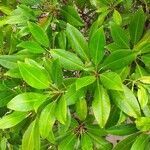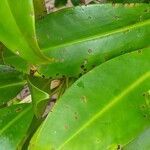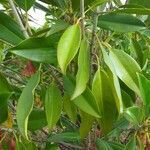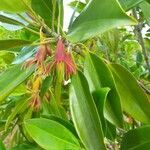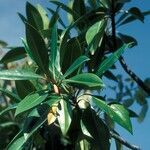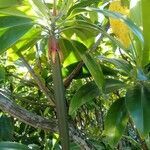Glabrous tree up to 12 m. tall (nearer half this height in our area), bark reddish-brown.. Leaves dark green; blade narrowly to broadly elliptic, 5–15 cm. long, subacuminate above to an acute apex, cuneate below to an acute base, petiole up to 3 cm. long.. Flowers solitary; peduncles recurved, about 1 cm. long; buds narrowly ellipsoid, terete, c. 25 × 10 mm.. Calyx pinkish-green to reddish-brown; tube 1–2 cm. long; lobes (10–) 12 (–15), linear, 1.8–2.0 cm. long, apex acute.. Petals white, soon turning brown, about 1.5 cm. long, conduplicate below, bifid with a median seta, stiffly pubescent, especially below; lobes 3–3.5 mm. long, (bi-or) tri-ciliate apically.. Anthers 4 mm. long, dorsifixed, mucronate above; filaments 6 or 8 mm. long (one shorter and one longer in each pair).. Ovary 3-celled.. Fruit turbinate, 2 cm. long.. Hypocotyl up to 11 cm. long on tree, terete or only shallowly and bluntly longitudinally ridged, swollen ± uniformly throughout length.. Fig. 3.
Trees 6-20 m tall, d.b.h. 30-60 cm. Bark gray, deeply fissured. Stipules often reddish, ca. 4 cm, interpetiolar, caducous. Petiole 2-4.5 cm; leaf blade elliptic-oblong, 8-21 × 4-7(-9) cm, leathery, glabrous, base cuneate to rarely obtuse, apex acute. Pedicel 1-2.5 cm. Flowers in axils of upper leaves, solitary, red or pinkish red, ca. 3 cm. Calyx lobes 10-14, linear, 1.5-2 cm, glabrous. Petals 12-14, 1.3-1.5 cm, outer margin fringed with white silky hairs; sinus bristles 3 or 4 per petal, 2-3 mm, distinctly exceeding petals. Stamens twice as many as petals, 8-11 mm; filaments filiform; anthers linear to lanceolate, 4-5 mm. Disk cup-shaped. Ovary inferior, 3-loculed; style filiform, ca. 1.5 cm; stigma lobes 3 or 4. Fruit adnate to calyx tube, ca. 2.5 mm; persistent calyx on fruit or hypocotyls ribbed only apically. Seed 1, viviparous. Hypocotyl cigar-shaped, slightly angular, 15-25 × 1.5-2 cm. Fl. May-Jun. 2n = 26.
Tree to 20 m high; bark dark grey; knee roots abundant. Leaves elliptic, acute; lamina 8–20 cm long, 3–9 cm wide; petiole 2–4 cm long; stipules often reddish. Flowers solitary, c. 3.5 cm long at anthesis; pedicel 1–2.5 cm long, recurved, red on at least one side. Hypanthium often reddish, not ribbed or indistinctly ribbed near top only. Sepals 10–16, linear-subulate, thick, pale pink to bright red. Petals c. 1.5 cm long, 2-lobed, white turning brown; margins and base pubescent; soft bristles 2 or 3 terminating each lobe, 1 in sinus. Anthers c. 4 mm long, mucronate. Hypocotyl 10–25 cm long, c. 1.5 cm wide, straight, terete or slightly ribbed, rounded at apex.
Evergreen, mangrove tree or shrub, 7-15 m high. Leaves opposite, oblong to elliptic, leathery. Flowers axillary, solitary. Calyx 8-15-lobed, leathery; tube turbinate; lobes linear-lanceolate. Petals as many as calyx lobes, oblong, concave, bifid, lobe and midrib produced into awns. Stamens twice as many as petals; filaments shorter than petals; anthers linear, hooked at apex. Ovary inferior, 2-4-locular, 2 ovules per locule. Flowering time Aug.-May. Fruit a turbinate, leathery berry, crowned with persistent calyx; 1-seeded by abortion. Seed pendulous, germinating before fruit-fall, developing a hypocotyl with longitudinal ridges.
Leaf-lamina usually 6–12 x 2–6 cm., narrowly to broadly elliptic or sometimes obovate-elliptic; apex acute, subacute or shortly acuminate; margins somewhat revolute; base narrowed into the petiole, cuneate or subcuneate; midrib rather prominent below, lateral nerves slightly prominent above and just visible to obscure beneath; petiole usually 1–3 cm. long; stipules up to 4 x 1 cm., entire and involute, acute at the apex and truncate at the base.
Petals c. 1·5 cm. long, ± oblong, conduplicate and costate inside, 2-lobed at the apex (the sinus with a median seta c. 4 mm. long and the lobes c. 5 mm. long, obtuse, apically 2–3-fimbriate), white or cream, soon turning brown, sparsely hirsute at the margins and densely hirsute at the base, coriaceous.
Shrub or tree up to 7(15) m. high; branches terete, smooth with subcircular scars of the petioles of the fallen leaves and annular scars of the fallen stipules; bark fibrous, light brown, reddish-brown or grey.
Hypocotyl up to 15 cm. long and 1·2 cm. in diameter while on the tree, only narrowing a little at both extremities, shallowly and bluntly longitudinally ridged.
Calyx pinkish-green to reddish-brown; calyx-tube 1–2 cm. long, obconical; calyx-lobes (10)12(14), 1·5–2 cm. long, triquetrous, narrow, very acute at the apex.
Flowers solitary, peduncles c. 1 cm. long, ± terete, arching; flower-buds c. 27 x 7 mm., narrowly ellipsoid, acute, strongly ribbed, glabrous.
Stamens (20)24(28), paired, oppositipetalous; filaments 6 or 8 mm. long; anthers c. 6 mm. long, mucronate at the apex.
Ovary c. 4 mm. long, (2)3(4)-locular; style c. 20 mm. long, shortly (2)3(4)-lobed at the apex.
Fruit a turbinate berry crowned by the calyx-lobes, unilocular, 1-seeded.
